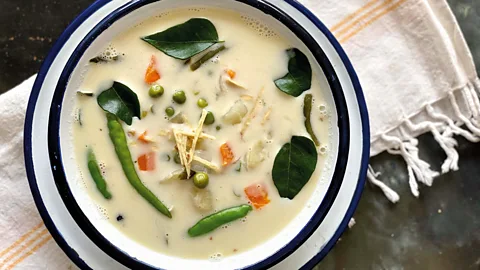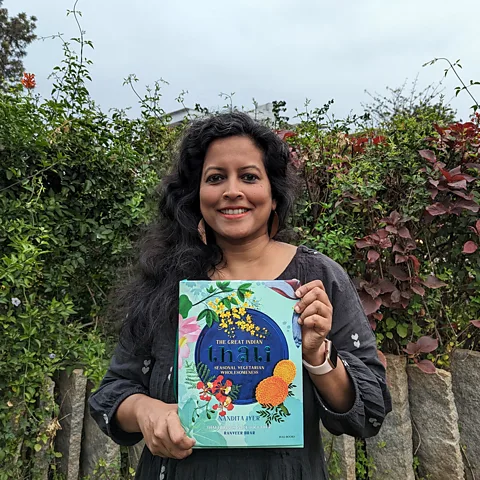By Charukesi RamaduraiFeatures correspondent

 Roli Books
Roli BooksIn The Great Indian Thali cookbook, Nandita Iyer shares her recipe for a mild, coconut-based stew made with seasonal vegetables and a hint of spice.
Close your eyes and think of Indian curry, and it is very likely that a rich, orangey-red gravy comes to mind, like the fiery chicken tikka masala; or a thick, green sauce that is the base for popular dishes like saag paneer or hariyali chicken.
But far away from these dishes that originate in the north Indian state of Punjab – both in terms of geography and flavours – is the Kerala ishtu from the deep south. Ishtu, a variation on the English word stew, is a mild, creamy, pale dish made with seasonal vegetables and enhanced with just a hint of spices. It's a hearty dish that comes together in less than 30 minutes and can be found in home cooking as well as in restaurants serving Kerala cuisine.
Kerala has always been the fertile home ground for spice cultivation in India, which is what brought everyone from the Arabs and the Chinese to the Portuguese and the Dutch – and then the British – to this part of the country over many centuries. While the legacy of all these incomers lives on in art and architecture, food is where the influence of these colonisers remains the strongest.
In many parts of India, where the British stew has been adapted to suit local palates, meat forms the backbone of the dish, with the stew thickened using yoghurt or ghee. The Kerala ishtu, however, can be made with or without meat – either using beef or lamb, or just a medley of vegetables – and gets its unique flavour and body from coconut milk.
Doctor and food writer Nandita Iyer shares a recipe for vegetarian Kerala ishtu in her book The Great Indian Thali: Seasonal Vegetarian Wholesomeness, published in October 2022. Literally meaning "platter" or "plate", the thali is a unique Indian concept that brings together several dishes (usually from a specific area or around a theme) to create a wholesome meal.
Talking about the inspiration for this book, Iyer said that a thali makes us look at food as an amalgamation of nutrients, instead of as separate ingredients. "In Indian cuisine, the concept of meal courses does not exist. We tend to eat everything together – with the carb like rice or roti as the main star, and lentils, vegetables, meat and everything else in a supporting role. It is super flexible and can have just three dishes or 20 dishes," she explained.

 Nandita Iyer
Nandita IyerThe book has 80 recipes that are divided by season to promote the use of fresh, local ingredients available at specific times of the year. And there is a reason for this. According to Iyer, Indian vegetarian food has been homogenised; dishes from the state of Punjab are often the only ones that represent vegetarian Indian food both within the country and beyond. It's important for people to know that Indian food varies from region to region, depending on what's grown there.
She said, "I think India has incredible biodiversity in terms of microclimates and cultures. Every 50km, the language changes, the food changes, and even for the same dish, there are so many variations in the recipe. This makes our lives so much richer, but we don't fully appreciate it. And if we don't begin to embrace and incorporate the richness of it in our lives, we will lose it soon and our lives will be very bland, like eating food with just salt and pepper."
Iyer has accordingly tried to source and use specific regional and seasonal vegetables, spices and other ingredients for recipes in the book. Describing her Kerala ishtu, she said, "It is simple and quick, and can be made using vegetables available in the fridge (fresh or frozen), with some tofu thrown in for protein."
"It is also light on the stomach – just a couple of spices and coconut milk give it such a rich flavour. And it can be had with a slice of sourdough toast or just some rice. It is minimalistic, and at the same time, pretty versatile."

 Roli Books
Roli Books
Ishtu: Kerala Vegetable Stew
By Nandita Iyer
Serves 4
Ingredients
2 tbsp coconut oil
2 green cardamoms
3 to 4 cloves
1 cinnamon stick (2½cm/1in)
5 to 6 black peppercorns
20g ginger, peeled and julienned
2 sprigs curry leaves
1 large onion, peeled and sliced
1 large carrot, peeled and diced
2 medium potatoes, peeled and diced
½ cup (60g) green peas
12 to 14 green beans, julienned
1½ tsp salt
½ tsp white pepper powder (optional)
400ml (13½oz) coconut milk
2 green chillies, slit
Method
Step 1
In a large pan, heat 1 tbsp of the oil over medium heat. Add the whole spices and fry for 30 seconds until aromatic. Add half the julienned ginger and one sprig of curry leaves. Fry until the curry leaves turn bright green. Stir in the sliced onion and fry over medium heat for 3-4 minutes until it softens a bit.
Step 2
Mix in the remaining vegetables and sauté for a few seconds. Add in ½ cup of water, the salt and the white pepper. Cook for 6-8 minutes, until the vegetables turn slightly soft but not mushy (they should retain some crunch).
Step 3
Add in the coconut milk, green chillies and the remaining ginger. Bring to a gentle simmer. Take the pan off the heat. Add a final layer of flavour with the remaining 1 tbsp of coconut oil and sprig of curry leaves. Serve hot with plain rice, lacy aapams, or string hoppers.
(Recipe adapted from The Great Indian Thali: Seasonal Vegetarian Wholesomeness by Nandita Iyer, Roli Books, 2022.)
BBC.com's World's Table "smashes the kitchen ceiling" by changing the way the world thinks about food, through the past, present and future.
---
Join more than three million BBC Travel fans by liking us on Facebook, or follow us on Twitter and Instagram.
If you liked this story, sign up for The Essential List newsletter – a handpicked selection of features, videos and can't-miss news delivered to your inbox every Friday.
https://ift.tt/93sOyH5
Entertainment
No comments:
Post a Comment